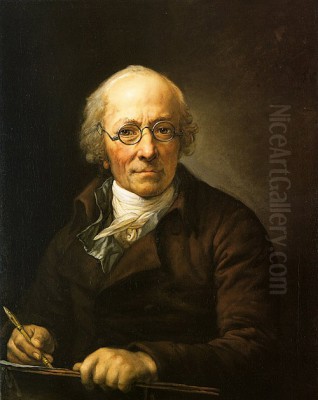
Anton Graff stands as one of the most significant and prolific portrait painters of the German-speaking world during the latter half of the 18th and the early 19th centuries. Born in Switzerland but spending the majority of his highly successful career in Germany, particularly Dresden, Graff became the preeminent visual chronicler of the Enlightenment and burgeoning Romantic eras. His canvases captured the likenesses and, more importantly, the inner character of royalty, nobility, intellectuals, artists, and the rising bourgeoisie, leaving behind an invaluable gallery of the period's leading figures. His technical mastery, combined with a profound psychological insight, secured his position not only as a sought-after court painter and respected academic but also as a pivotal figure in the history of European portraiture.
Swiss Roots and Early Artistic Formation
Anton Graff was born on November 18, 1736, in the town of Winterthur, located in the canton of Zürich, Switzerland. He hailed from an artisan background; his father was a craftsman, suggesting a household where manual skill and practical arts were valued, though perhaps not initially fine art. Despite this modest beginning, young Anton displayed a clear aptitude and passion for drawing and painting. Recognizing his son's talent, his father supported his artistic inclinations.
In 1753, at the age of 17, Graff began his formal artistic training in his hometown under the guidance of Johann Ulrich Schellenberg (1709-1795). Schellenberg was a reasonably well-regarded local painter and engraver, providing Graff with a foundational understanding of drawing, composition, and painting techniques prevalent in the Swiss-German tradition of the time. This initial instruction was crucial in honing his innate abilities and setting him on a professional path.
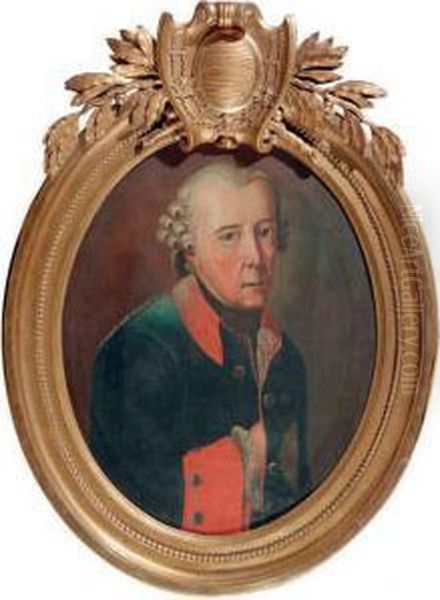
Seeking broader horizons and more advanced training, Graff left Winterthur after approximately three years. His ambition led him to Augsburg, a major artistic and publishing center in Southern Germany at the time. From 1756, he continued his studies under the engraver and miniature painter Johann Jakob Haid (1704-1767). Augsburg exposed Graff to a more diverse artistic environment, likely including influences from South German Baroque and Rococo traditions, as well as the strong local tradition of printmaking, which emphasized precision and detail – qualities that would later manifest in his portraiture. His time with Haid further refined his technical skills, particularly in capturing fine details and likenesses, essential for portrait work.
Establishing a Career: Ansbach and the Call to Dresden
Following his studies in Augsburg, Graff's journey continued. He traveled, seeking opportunities to practice his craft. For a period, he worked in Ansbach, the residence of the Margraves of Brandenburg-Ansbach. Here, he found employment assisting the court painter Leonhard Schneider (d. 1766). While perhaps not an independent master position initially, this role provided invaluable experience within a court setting, exposing him to the demands and etiquette of aristocratic patronage. He likely honed his skills further by copying works or assisting Schneider with commissions, gaining practical knowledge of large-scale portraiture and courtly representation.
Graff's talent did not go unnoticed for long. His reputation as a skilled portraitist began to grow. A significant turning point came in 1765. Following the death of the previous court painter, Louis de Silvestre, the electoral court of Saxony in Dresden sought a successor. Graff, possibly through recommendations or trial pieces, successfully applied for the prestigious position. He was appointed court painter to Frederick Christian, Elector of Saxony, although the Elector himself died shortly thereafter. Nevertheless, the appointment was upheld by his successors.
This move to Dresden in 1766 marked the definitive start of Graff's mature and most successful career phase. Dresden, despite suffering damage during the Seven Years' War, remained a major cultural capital, often called "Florence on the Elbe." It boasted rich art collections and a vibrant intellectual life. Simultaneously with his court appointment, Graff was also made a professor at the newly reorganized Dresden Academy of Fine Arts (Hochschule für Bildende Künste Dresden), alongside other notable artists like the Venetian Bernardo Bellotto (1721-1780) and the Swiss landscape painter Adrian Zingg (1734-1816). This dual role as court painter and educator solidified his status within the artistic establishment and provided him with both consistent patronage and a platform to influence the next generation of artists. He would remain associated with the Academy for the rest of his life.
The Portraitist's Craft: Style, Technique, and Influences
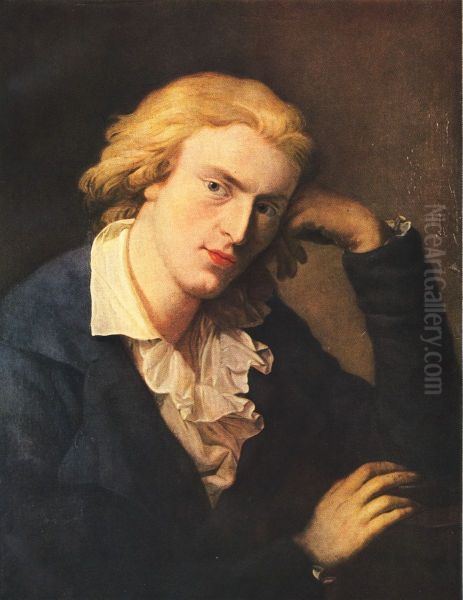
Anton Graff's artistic style is firmly rooted in the traditions of late 18th-century portraiture, characterized by a commitment to realism and meticulous observation, yet infused with the burgeoning sensibility of the Enlightenment's focus on individual character and rationality. While often categorized within the German Neoclassical or early Romantic periods, his work largely eschews overt classical allegory or dramatic Romantic emotionalism, focusing instead on the truthful and insightful depiction of the sitter.
His technique was marked by exceptional draftsmanship and a refined handling of oil paint. Graff possessed an uncanny ability to capture not just a physical likeness but the perceived personality and intellectual presence of his subjects. Faces are rendered with remarkable precision and subtlety, revealing nuances of expression, age, and temperament. He paid close attention to the play of light and shadow (chiaroscuro), often using it to model features effectively and create a sense of volume and presence, typically focusing light on the face to draw the viewer's attention to the sitter's character.
Graff's treatment of textures, particularly fabrics like silk, velvet, lace, and fur, was masterful. Clothing and accessories were rendered with painstaking detail, contributing to the overall realism and indicating the social status of the sitter, yet rarely overwhelming the focus on the individual's face and demeanor. His color palettes were generally sophisticated and harmonious, often employing rich but controlled tones appropriate to the sitter and the formal context of the portrait.
While developing his distinct style, Graff absorbed various influences. His early training likely exposed him to Swiss and South German traditions. The precision evident in his work may owe something to his time with the engraver Haid. Art historians also note the influence of 17th-century Dutch portraiture, particularly in the realistic rendering and psychological depth, perhaps recalling masters like Rembrandt or Frans Hals. Furthermore, contemporary French portraitists like Maurice Quentin de La Tour (1704-1788) or Jean-Baptiste Greuze (1725-1805), known for their naturalism and expressive qualities, may have provided points of reference, though Graff maintained a more sober, less overtly sentimental approach than Greuze. Despite these influences, Graff forged a personal style recognized for its clarity, honesty, and penetrating insight.
A Gallery of the Enlightenment: Notable Sitters
Anton Graff's Dresden studio became a destination for the intellectual, artistic, and social elite of the German-speaking world and beyond. His position as court painter naturally brought him commissions from Saxon royalty and aristocracy, but his reputation quickly spread, attracting a diverse clientele. He became, in effect, the portraitist of the German Enlightenment (Aufklärung) and the subsequent Sturm und Drang and early Romantic movements.
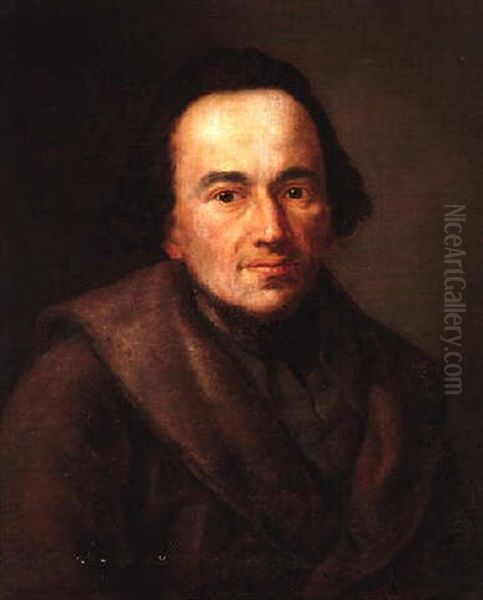
Among his most famous sitters was Frederick II (the Great) of Prussia (1712-1786). Although Graff worked primarily in Dresden, he traveled for important commissions, including visits to Berlin. His portrait of the aged Frederick the Great, painted from life in 1781, is widely considered the most accurate and insightful depiction of the monarch in his later years, capturing his weariness, intelligence, and formidable presence without resorting to idealized flattery. This portrait exists in several versions and copies, attesting to its contemporary significance.
Graff painted numerous leading figures of German literature and philosophy. He created iconic portraits of Gotthold Ephraim Lessing (1729-1781), the playwright and critic central to the Enlightenment. His portraits of Friedrich Schiller (1759-1805), the celebrated poet and dramatist, capture the intensity and idealism associated with the Sturm und Drang movement. While a definitive portrait of Johann Wolfgang von Goethe (1749-1832) by Graff is debated, he certainly moved within these intellectual circles and painted many associated figures.
Other prominent sitters included the philosopher Moses Mendelssohn (1729-1786), a key figure in the Haskalah (Jewish Enlightenment); the poet Christoph Martin Wieland (1733-1813); the physician and writer Johann Georg Ritter von Zimmermann (1728-1795); the poetess Elisa von der Recke (1754-1833); and the philosopher Johann Gottfried Herder (1744-1803). He also painted fellow artists, such as the engraver Daniel Chodowiecki (1726-1801), who himself was a prolific documenter of the era, and the painter Adam Friedrich Oeser (1717-1799), Goethe's drawing teacher in Leipzig. This extensive gallery serves as an invaluable visual record of the individuals who shaped the cultural and intellectual landscape of the time. Graff's ability to connect with and convincingly portray such a wide range of personalities underscores his skill and adaptability.
Masterworks: Key Paintings Explored
While Anton Graff's oeuvre is vast, several works stand out as particularly representative of his style and significance. His portraits are consistently characterized by their technical brilliance and psychological acuity.
The aforementioned Portrait of Frederick the Great (1781) is arguably his most famous single work. Unlike many idealized state portraits, Graff depicted the king in his later years with unflinching realism, showing his aged features, simple attire (often his military uniform), and piercing gaze. It conveys authority mingled with the burdens of rule and intellectual depth, aligning with the Enlightenment ideal of the "philosopher king" while remaining profoundly human. Its perceived truthfulness made it highly sought after.
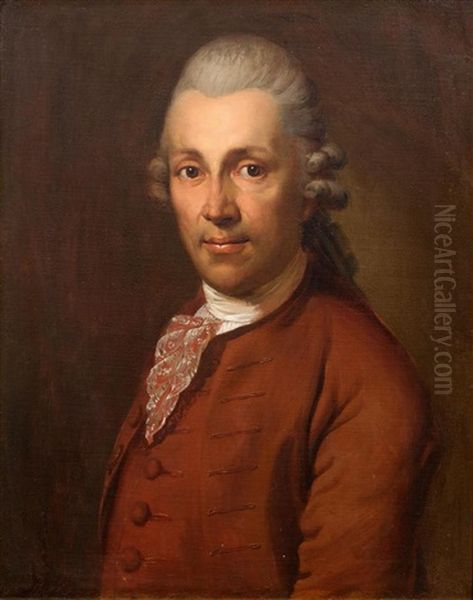
His Portrait of the Poetess Elisa von der Recke (c. 1797-1800) exemplifies his ability to capture female intellect and sensitivity. The portrait shows her in a thoughtful pose, her expression conveying intelligence and perhaps a hint of melancholy. The rendering of her features and the soft lighting contribute to an intimate portrayal that goes beyond mere surface likeness, reflecting the era's growing appreciation for individual sentiment.
The double portrait Elisabeth Sophie Graff (née Haase), the Artist's Second Wife, and their Daughter Caroline Susanne (c. 1785-1788) is a testament to his skill in depicting personal relationships and domestic intimacy. While still possessing the clarity and detail typical of his work, the painting conveys familial warmth and affection. The interaction, or lack thereof, between mother and child, and their individual gazes, invite contemplation about their inner lives. It showcases his ability to handle more complex compositions involving multiple figures.
The Portrait of the Doctor and Philosopher Johann Georg Ritter von Zimmermann (c. 1780s/90s) captures the intellectual gravity of the well-known Swiss physician and author. Zimmermann, known for his work on solitude and melancholy, is presented with a serious, introspective expression. Graff masterfully renders the textures of his clothing and the quality of light on his face, emphasizing the sitter's thoughtful nature and professional standing.
Graff also produced numerous Self-Portraits throughout his career, offering fascinating insights into his self-perception and artistic development. These range from confident depictions of the successful artist to more introspective studies in later life. A notable example is the Self-Portrait housed in the Gemäldegalerie Alte Meister in Dresden, showing him perhaps in middle age, palette in hand, gazing directly at the viewer with a steady, analytical expression – the artist assessing himself as keenly as he assessed his sitters. These self-portraits trace his journey and stand as significant works in their own right.
Other important works include his portraits of Lessing, Schiller, Moses Mendelssohn, and countless members of the Saxon court and German nobility, each demonstrating his consistent quality and insightful approach. His portrait of Count Christoph Urbanowicz is also noted, representing his work for aristocratic patrons beyond the immediate Saxon circle.
Beyond Portraiture: Landscapes and Later Work
While Anton Graff is overwhelmingly known for his portraiture, his artistic interests extended to landscape painting, particularly in his later years. This shift reflects a broader trend in European art around the turn of the 19th century, where landscape evolved from being primarily a backdrop or topographical record into a genre capable of conveying emotion and sublime experience, prefiguring Romanticism.
His landscape works, though less numerous than his portraits, reveal a different facet of his artistic sensibility. They often depict scenes from the picturesque regions around Dresden, such as Saxon Switzerland, or views encountered during his travels. These paintings show a sensitivity to atmosphere, light, and the natural environment. While still grounded in careful observation, some of his later landscapes exhibit a looser brushwork and a greater emphasis on mood and the effects of light and weather, moving away from the meticulous detail of his portraits.
Art historians see in Graff's landscapes early indications of the Romantic approach to nature that would be more fully developed by artists like Caspar David Friedrich (1774-1840), who was active in Dresden during Graff's later years, though their styles remained distinct. Graff's engagement with landscape demonstrates his continued artistic exploration even late in his career and his responsiveness to the changing artistic currents of his time. It suggests an artist seeking new avenues for expression beyond the constraints of formal portraiture, finding in nature a subject for contemplation and perhaps a more personal form of artistic statement. These landscapes, while secondary to his main body of work, add an important dimension to our understanding of his artistic range.
The Dresden Academy and Graff's Influence
Anton Graff's long tenure as a professor at the Dresden Academy of Fine Arts, from 1766 until his death in 1813, cemented his influence on subsequent generations of artists in Germany. Alongside his prolific output as a painter, his role as an educator was significant. He provided rigorous training grounded in the principles of careful observation, solid draftsmanship, and technical proficiency – the hallmarks of his own work.
His students benefited from his extensive experience and his reputation, which attracted aspiring artists to Dresden. Among those documented as having studied under Graff or been significantly influenced by him during their time at the Academy were several figures who would go on to achieve recognition. These include Emma Körner (1788-1815), sister of the poet Theodor Körner and a talented painter in her own right, associated with the Dresden Romantic circle; Philipp Otto Runge (1777-1810), a leading figure of early German Romantic painting, known for his portraits, allegories, and color theory, who studied briefly in Dresden around 1801; and Carl Ludwig Kaaz (1773-1810), a landscape painter who also worked in portraiture and was a friend of Goethe.
Graff's teaching likely emphasized the importance of capturing character and achieving a high degree of naturalism, principles that resonated with the developing aesthetics of the time, bridging late Enlightenment clarity with emerging Romantic individualism. His own success provided a powerful model for his students. Furthermore, his presence contributed to the Academy's reputation as a leading art institution in the German-speaking lands during this period, fostering an environment where different artistic ideas could interact, involving colleagues like Adrian Zingg and later figures. His influence extended beyond his direct pupils, as his works were widely known and studied, setting a standard for portraiture in Germany for decades.
Contemporaries and the Artistic Milieu
Anton Graff operated within a rich and dynamic artistic milieu, particularly in Dresden, but also through his travels and connections across the German-speaking world and beyond. His career overlapped with several major artistic shifts, from the late Rococo and the rise of Neoclassicism to the beginnings of Romanticism.
In Dresden, besides colleagues at the Academy like Bellotto and Zingg, he would have been aware of the work of earlier court painters and the rich collections of the Electors. His contemporaries in the broader German art scene included figures like Daniel Chodowiecki in Berlin, whose engravings offered a parallel visual chronicle of the era, often focusing on bourgeois life. Adam Friedrich Oeser in Leipzig was another significant figure, influential as a teacher (notably of Goethe) and proponent of Neoclassical ideas inspired by Johann Joachim Winckelmann.
Internationally, Graff's work can be situated alongside prominent European portraitists. In England, this was the era of Sir Joshua Reynolds (1723-1792) and Thomas Gainsborough (1727-1788), whose styles differed but who similarly dominated portraiture in their country. In France, artists like Élisabeth Vigée Le Brun (1755-1842) achieved international fame. While Graff's style remained distinctly German, he was part of this broader European phenomenon where portraiture flourished, serving royalty, aristocracy, and increasingly, the intellectual and middle classes.
Other notable German or Austrian artists active during parts of Graff's career include Anton Raphael Mengs (1728-1779), a leading proponent of Neoclassicism often considered Graff's rival in terms of prestige, though Mengs worked extensively outside Germany (in Rome and Madrid); Angelica Kauffman (1741-1807), a Swiss-born history painter and portraitist of international renown, primarily active in London and Rome; Johann Heinrich Wilhelm Tischbein (1751-1829), famous for his portrait of Goethe in the Roman Campagna; Heinrich Friedrich Füger (1751-1818), a prominent Neoclassical painter in Vienna; and Josef Grassi (1757-1838), another portraitist who worked in Vienna and later succeeded Graff as professor in Dresden. Graff's interaction with these figures varied, but his work was certainly known and assessed in relation to theirs, contributing to the complex artistic landscape of the late 18th and early 19th centuries. His connections also extended to intellectuals like the philosopher and art theorist Johann Georg Sulzer (1720-1779), whose ideas on aesthetics were influential during the Enlightenment.
Legacy and Art Historical Significance
Anton Graff's position in art history is secure as the leading portrait painter in the German-speaking world during the late Enlightenment and early Romantic periods. His remarkable productivity – estimates of his output range from around 1000 to over 2000 paintings, including numerous replicas and studio versions – combined with his consistent quality and insightful characterizations, makes his oeuvre an unparalleled resource for understanding the era.
His primary contribution lies in his mastery of realistic portraiture infused with psychological depth. He moved beyond the often stiff formality of earlier court portraiture and the decorative tendencies of the Rococo, embracing the Enlightenment's focus on reason, individuality, and inner virtue. His portraits are valued not only as likenesses but as profound character studies, capturing the intellectual energy, gravitas, or sensitivity of his sitters. The sheer number of prominent figures he depicted makes his work an essential visual archive of the period's key personalities in politics, literature, philosophy, science, and the arts.
Graff is often seen as a transitional figure. While rooted in the observational traditions of the Enlightenment and employing techniques aligned with Neoclassical clarity, his emphasis on individual character and his later exploration of landscape painting connect him to the emerging Romantic sensibility. He paved the way for later 19th-century portraitists in Germany, although the rise of Romanticism soon led art in different directions.
His reputation was high during his lifetime and has remained strong. His works are held in major museums across Germany and Switzerland, including the Gemäldegalerie Alte Meister in Dresden, the Alte Nationalgalerie in Berlin, the Museum der bildenden Künste Leipzig, the Kunsthaus Zürich, and his hometown museum in Winterthur. His portrait of Frederick the Great remains one of the most iconic images of the monarch. While debates exist regarding the exact number of works produced by his own hand versus his studio, his overall impact is undeniable. He documented an age and its people with unparalleled skill and insight, leaving a legacy that is both artistically significant and historically invaluable.
Conclusion: Chronicler of an Age
Anton Graff navigated the complex cultural and political landscape of the late 18th and early 19th centuries with remarkable success. From his beginnings in provincial Switzerland, he rose to become a sought-after court painter, a respected academic, and the portraitist of choice for the intellectual elite of the German Enlightenment. His dedication to capturing not just the external appearance but the internal essence of his sitters resulted in a body of work that is both aesthetically accomplished and profoundly revealing.
Through his thousands of portraits, Graff provided a face to an era of immense change, capturing the personalities who shaped modern German thought and culture. His commitment to realism, combined with subtle psychological insight and technical mastery, ensured his place as a pivotal figure in European portraiture. While his later landscapes hint at the burgeoning Romantic movement, it is his penetrating portraits that constitute his most enduring legacy, offering us a direct and compelling encounter with the individuals who defined a transformative period in history. Anton Graff remains not just a painter of faces, but a visual historian of the human spirit during a time of profound intellectual and artistic ferment.